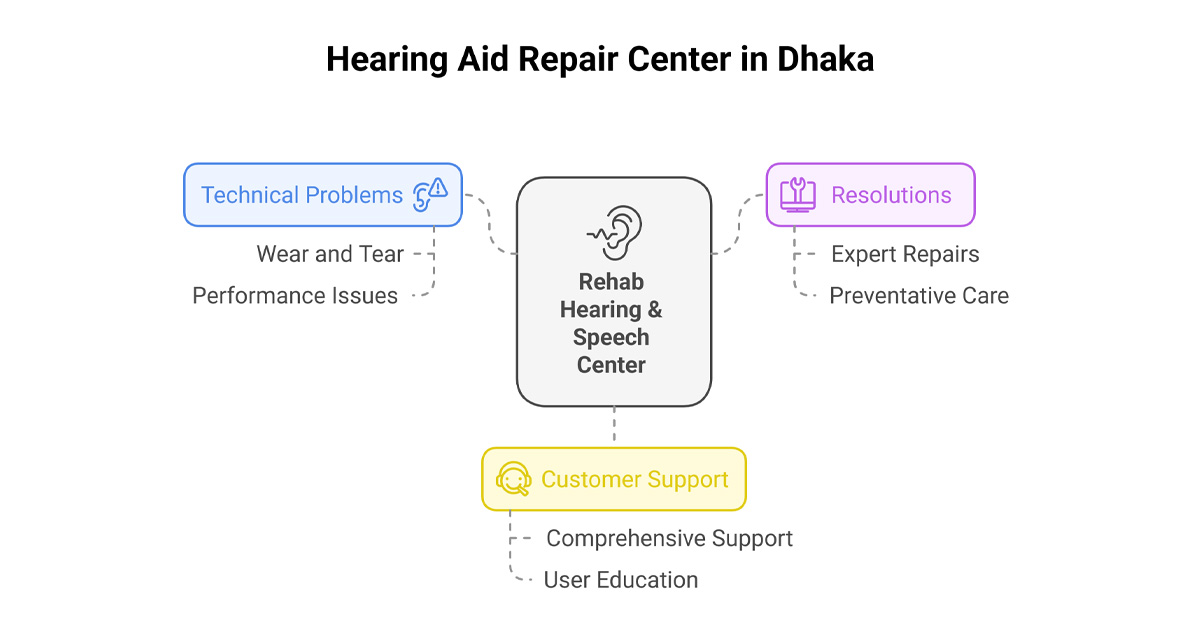Intro: Hearing Aid Repair Center in Dhaka
Hearing aids are essential devices that enhance the quality of life for individuals with hearing loss, enabling them to engage more fully in daily activities and communication. However, like all electronic devices, hearing aids are prone to wear and tear, and occasional repairs may be necessary to maintain optimal performance. In Dhaka, the demand for reliable hearing aid repair services has grown, with numerous centers specializing in fixing common technical issues, providing maintenance, and offering comprehensive customer support. The Hearing Aid Repair Center in Dhaka plays a crucial role in ensuring the longevity and functionality of hearing aids through expert repairs, preventative care, and maintenance services. Whether it’s a minor adjustment or a more complex repair, finding a trusted center can save users from the inconvenience of disrupted hearing and ensure their devices perform at their best.
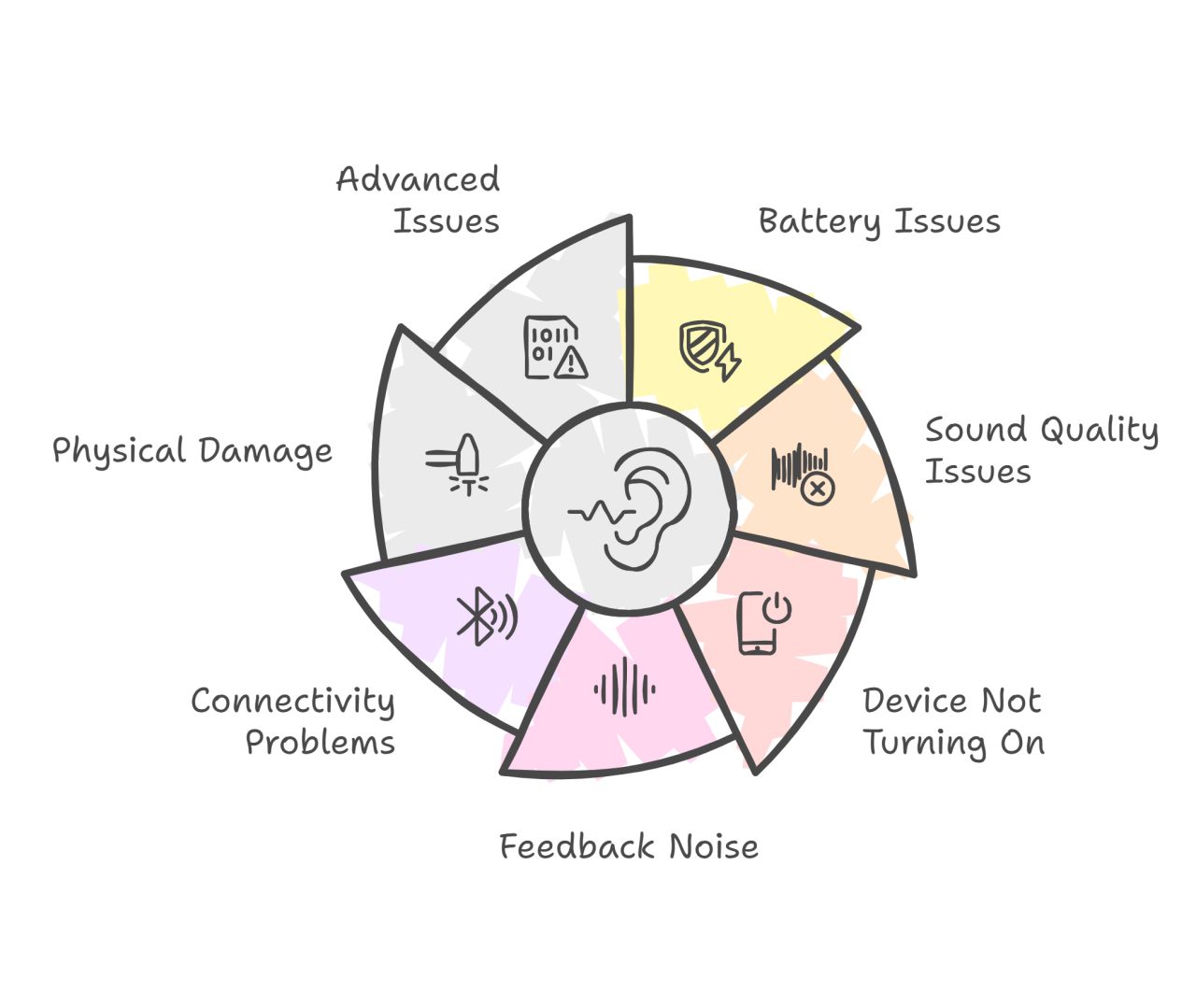
Common Technical Problems with Hearing Aids
Battery Issues
Dead or weak batteries causing interruptions: Hearing aids rely heavily on batteries for smooth operation, and dead or weak batteries can lead to sudden device shutdowns or inconsistent performance. Over time, batteries may lose their capacity faster, especially if exposed to extreme temperatures or frequent overuse.
Tips to identify battery-related problems: If your hearing aid frequently stops working, check for battery corrosion or improper battery insertion. Use a battery tester to confirm power levels, and always keep spare batteries on hand. Replacing with high-quality, compatible batteries ensures better performance and longevity.
Sound Quality Issues
Distorted or unclear audio: This problem can make conversations and environmental sounds hard to discern. It often stems from damaged speakers, poor amplification, or interference caused by earwax or moisture buildup inside the hearing aid.
Low or muffled sound output: Commonly caused by clogged earwax filters, blocked tubing, or improper device calibration. Regular cleaning and professional servicing can help restore clarity.
Device Not Turning On
Causes of power failure: A hearing aid that won’t power on could result from depleted batteries, corroded battery contacts, or faulty internal circuits. Additionally, exposure to moisture or water can damage sensitive electronic components.
Feedback Noise
Causes of whistling or buzzing sounds: Feedback occurs when sound from the hearing aid speaker leaks back into the microphone, creating an unpleasant loop. This is often due to improper fitting, a loose or damaged earmold, or incorrect device settings.
Improper fitting or damaged microphones: A poorly fitting device allows sound leakage, while a damaged microphone may distort audio or pick up unnecessary noise, leading to feedback issues.
Connectivity Problems
Bluetooth pairing issues with smartphones or other devices: Many modern hearing aids, including Simense Vibe Hearing Aids rely on Bluetooth for wireless connectivity. Issues such as failed pairing, dropped connections, or delays in streaming audio can arise from outdated firmware or software incompatibility with the connected device.
Firmware/software glitches: Sometimes, the device’s internal software may malfunction, causing erratic behavior or connectivity loss. Resetting the device or performing a software update can often resolve these problems.
Physical Damage
Broken casing, wires, or tubing in Behind-the-Ear (BTE) models: Prolonged use or mishandling may result in physical damage, such as cracked casings or frayed wires. Tubing in BTE models is particularly vulnerable to wear and tear, affecting sound delivery.
Moisture or earwax buildup affecting performance: Hearing aids are sensitive to moisture and debris. Sweat, humidity, or accidental exposure to water can damage internal components. Similarly, earwax buildup can clog sound ports or microphones, leading to muffled audio or complete device failure.
Advanced Issues and Rare Problems
Circuit board failures: Rare but severe, circuit board malfunctions require professional diagnostic tools and repairs to identify and resolve the issue.
Overheating or sudden shutdowns: These problems may occur if the device is exposed to high temperatures or if internal components are overburdened.
By understanding these common technical problems, users can take proactive steps to maintain their hearing aids, ensuring consistent performance and minimizing the need for major repairs. Regular check-ups at a trusted repair center like Rehab Hearing & Speech Center in Dhanmondi can help detect and address these issues before they escalate.
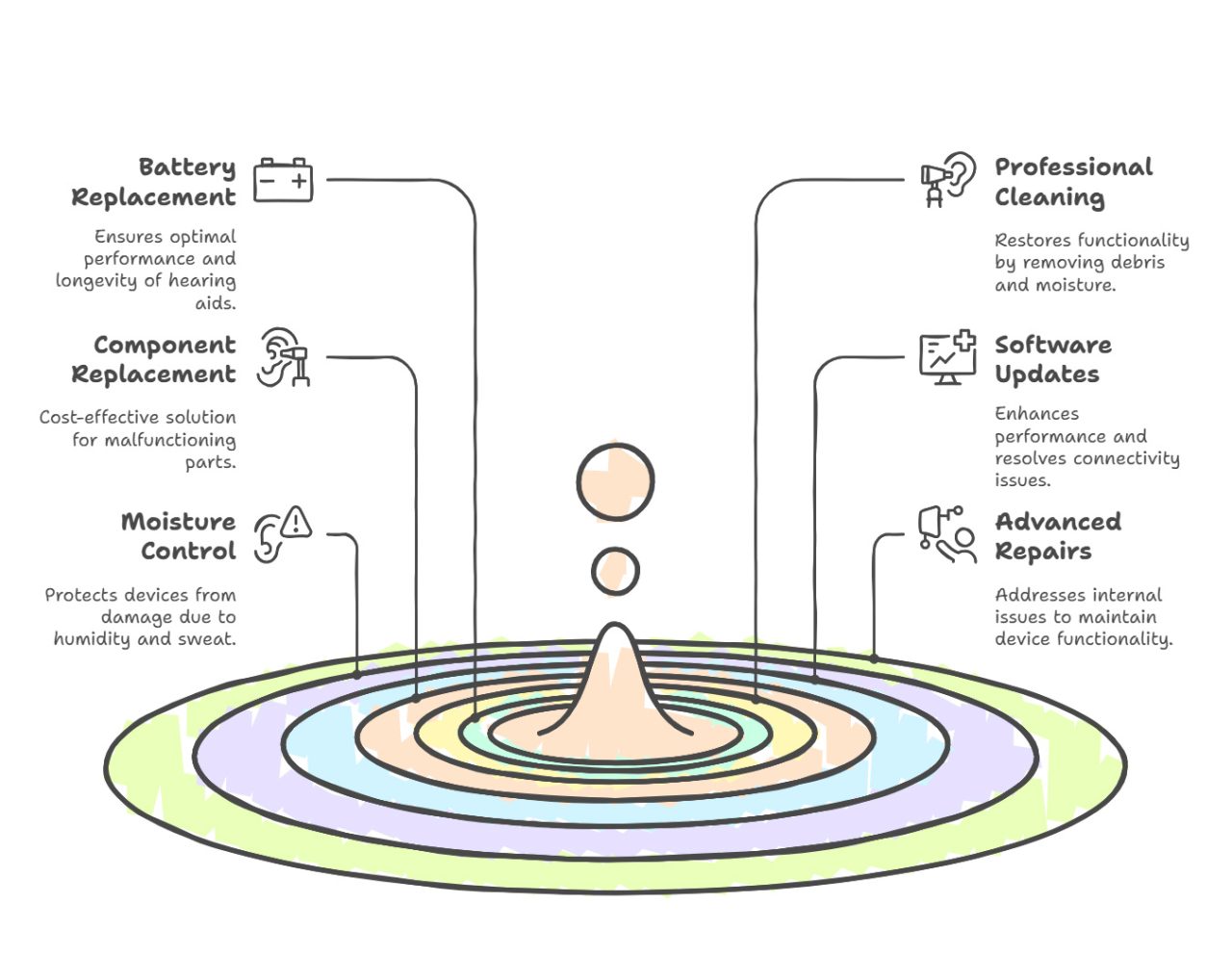
Technical Resolutions for Common Problems
Battery Replacement and Maintenance
Importance of using compatible batteries: Using the right type and brand of batteries is critical for optimal performance. Non-compatible or low-quality batteries may cause interruptions or fail prematurely, leading to unreliable device operation. Always opt for high-quality, manufacturer-recommended batteries for your hearing aids.
Tips for extending battery life: Store batteries in a cool, dry place, and remove them from the device when not in use for an extended period. Avoid storing batteries in extreme heat or humidity, as this can reduce their lifespan. Let the battery sit in the open air for a few minutes after removing the seal before inserting it into the device to maximize activation time.
Cleaning and Maintenance Services
Professional cleaning for earwax or moisture buildup: Earwax and moisture are two of the most common causes of hearing aid malfunctions. Professional cleaning removes debris from sound ports, microphones, and tubing, restoring the device’s functionality and sound clarity.
Regular maintenance schedules to prevent future issues: Scheduling periodic maintenance ensures that minor issues are addressed before they escalate into significant problems. A professional technician can inspect the device for signs of wear and tear, keeping it in top condition.
Component Replacement
Replacing microphones, receivers, or tubing: If a specific component of your hearing aid, such as the microphone or receiver, is malfunctioning, replacing it is often more cost-effective than replacing the entire device. For BTE models, replacing worn-out or damaged tubing is essential for sound delivery and comfort.
Addressing physical wear and tear effectively: Cracked casings, broken clips, or damaged buttons can all affect the usability of a hearing aid. Prompt repairs or replacements ensure the device remains durable and functional.
Software Updates and Calibration
Firmware upgrades to resolve connectivity issues: Hearing aids with Bluetooth or wireless features often require firmware updates to improve performance, compatibility, and stability. These upgrades can fix bugs and enhance device features.
Reprogramming devices for better performance: Recalibrating a hearing aid ensures that it matches the user’s current hearing needs. Audiologists can adjust the settings to enhance sound quality and clarity based on updated hearing tests, such as PTA, SRT & Impedence Tests.
Waterproofing and Moisture Control
Techniques to fix water-damaged hearing aids: If your device has been exposed to water, drying techniques like using a hearing aid dehumidifier or silica gel can help. However, in cases of severe water damage, professional repairs may be necessary to replace affected components.
Tips for protecting devices from sweat and humidity: Use protective covers or cases to shield your hearing aids from sweat and environmental moisture. Store the device in a dehumidifier overnight to remove any residual moisture.
Advanced Repairs
Circuit board repairs or replacements: If the internal electronics of the hearing aid are damaged, skilled technicians can repair or replace the circuit board. This requires specialized tools and expertise but can save the cost of buying a new device.
Diagnostic services for internal technical issues: Advanced diagnostic tools help identify problems with sensors, processors, or other internal components. A professional repair center can address these issues accurately, ensuring the device performs as expected.
By implementing these resolutions, hearing aid users can enjoy consistent and reliable performance. Regular servicing at a trusted repair center, like Rehab Hearing & Speech Center in Dhanmondi, ensures that these solutions are applied effectively, extending the lifespan of your hearing aid.
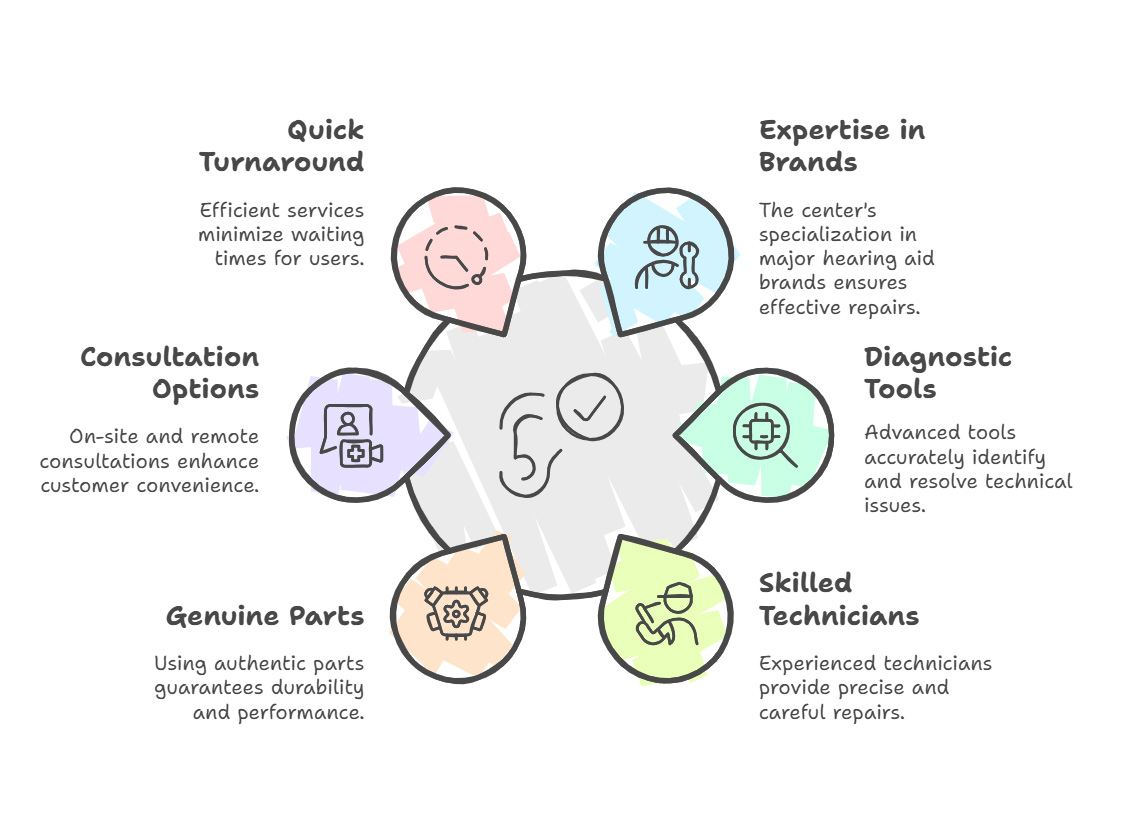
Why Choose Rehab Hearing & Speech Center for Repairs in Dhaka?
Expertise in Starkey Hearing Aids and Other Major Brands
Rehab Hearing & Speech Center specializes in repairing Starkey hearing aids, one of the most trusted names in the industry. Their expertise also extends to other major brands, ensuring that users with diverse device preferences receive high-quality repair services.
Advanced Diagnostic Tools for Accurate Problem Identification
With state-of-the-art diagnostic tools, the center ensures precise identification of technical issues. This eliminates guesswork, allowing technicians to provide targeted and effective solutions that restore the hearing aids to optimal functionality.
Skilled Technicians with Years of Experience
The center boasts a team of skilled technicians with extensive experience in handling a wide range of hearing aid models and problems. Their in-depth knowledge and hands-on expertise ensure that every repair is conducted with care and precision.
Use of Genuine Parts for Replacements
Rehab Hearing & Speech Center uses only genuine parts for component replacements. This guarantees the durability and performance of the repaired device, giving users peace of mind and confidence in the quality of the repairs.
For reliable and efficient hearing aid repairs in Dhaka, Rehab Hearing & Speech Center stands out as a trusted choice for customers seeking top-tier service and expertise.
Availability of On-Site and Remote Consultations
Rehab Hearing & Speech Center prioritizes customer convenience by offering both on-site and remote consultation services.
On-site consultations: Customers can visit the center for a hands-on assessment of their hearing aids by skilled technicians. In-person visits allow for immediate troubleshooting and repairs for issues that require physical intervention.
Remote consultations: For those unable to visit the center, remote services like phone or video consultations help identify problems and provide guidance on quick fixes or maintenance tips. This service is especially beneficial for customers living outside Dhaka or with mobility challenges.
Quick Turnaround Times for Minor Repairs
Timely repairs are essential to minimize disruptions for hearing aid users.
Same-day services: Minor issues, such as battery compartment cleaning, earmold adjustments, or software updates, are often resolved within a few hours, ensuring customers can resume using their devices quickly.
Priority service for urgent cases: For critical repairs that impact daily communication, priority services are available to reduce waiting times.
Warranty and Service Guarantees for Repaired Devices
Rehab Hearing & Speech Center ensures customer satisfaction by offering robust warranties and service guarantees.
Warranty for repairs: Most repairs come with a warranty period, ensuring customers receive support if the same issue reoccurs. This reflects the center’s confidence in the quality of its work.
Genuine parts guarantee: All replacement parts are guaranteed to be authentic, ensuring reliability and compatibility with the hearing aid model.
Post-repair support: Customers receive detailed guidance on maintaining their devices after repairs, helping to prevent repeat issues and extend the life of their hearing aids.
With these customer-focused services, Rehab Hearing & Speech Center in Dhaka stands out as a reliable partner for hearing aid users seeking comprehensive support and efficient solutions.
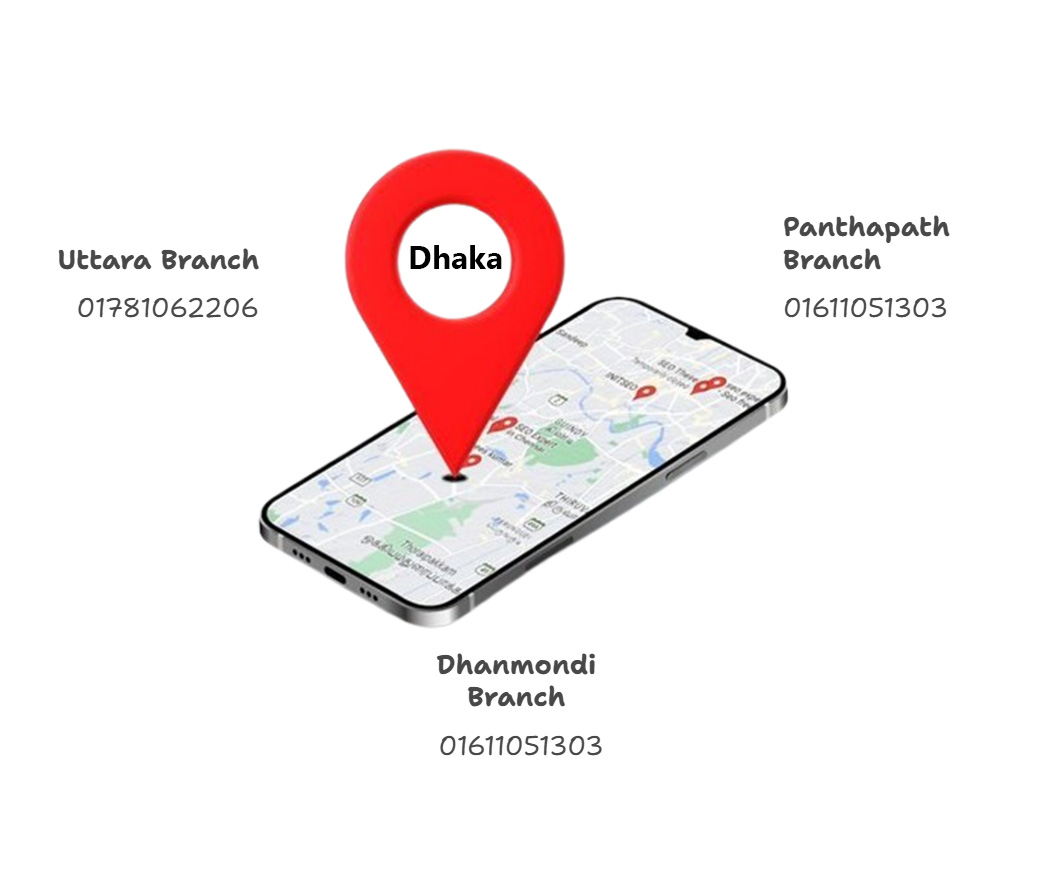
Contact Information
Check out our branch locations below and visit to the nearest one.
Panthapath Branch
Address: 44/7/A, Karim Tower, (Opposite to BRB Hospital), West Panthapath, Dhaka 1205, Dhaka 1205.
Mobile: 01611051303
Google Map: https://maps.app.goo.gl/hxBzDcRGprTkJeoQ7
Dhanmondi Branch
Address: Dr.Refatullah’s Happy Arcade, House: 3, Road: 3, Office: 24/1 (Ground Floor Beside North side of City College, Mirpur Rd, Dhaka.
Mobile: 01611051303
Google Map: https://g.co/kgs/btohJHc
Uttara Branch
Address: House No-46, Road No, 04 Sector No – 11, Dhaka 1230
Mobile: 01611051303
Google Map: https://g.co/kgs/HaPYitb
Gulshan Branch
Address: House # 36 (Century Park), Road # 117, Suite # 405 ( 3rd Floor), Gulshan 1, Dhaka 1212.
Mobile: 01611051303
Google Map: https://maps.app.goo.gl/2y6smzeVBd5SvvYCA
Chottogram Branch
Address:
Mobile: 01611051303
Google Map:
For professional hearing aid repair services, preventative care tips, and expert consultations, feel free to reach out to Rehab Hearing & Speech Center. Whether you need quick fixes, comprehensive maintenance, or expert advice, their team is ready to assist you.
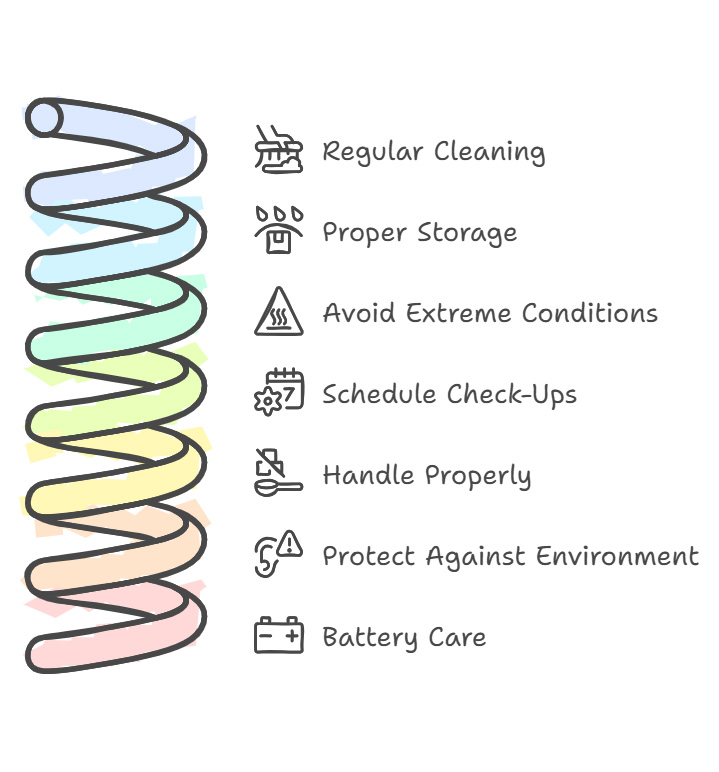
Tips to Minimize Hearing Aid Repair Issues
Regular Cleaning and Storage Recommendations
Consistent cleaning ensures that hearing aids function properly and reduces the chance of damage caused by buildup.
Daily cleaning routine: Wipe your hearing aids with a soft, dry cloth at the end of each day to remove any dirt, oil, or earwax. Use a small cleaning brush to gently clean the microphone openings, vents, and receivers without causing scratches.
Deep cleaning practices: For devices like Behind-the-Ear (BTE) hearing aids, regularly detach and clean the earmold and tubing. Soak the earmold in warm, soapy water, and ensure it is completely dry before reattaching.
Proper storage tips: Always store your hearing aids in a dedicated, dry case to prevent physical damage or exposure to dust. Use hearing aid dehumidifiers or silica gel packets in the case to maintain dryness, especially in humid climates like Dhaka.
Avoiding Exposure to Extreme Heat, Moisture, or Physical Shocks
Hearing aids are delicate electronic devices, and proper handling can save them from common damage.
Protect against moisture: Avoid wearing hearing aids in the rain, while swimming, or in extremely humid conditions. If you sweat heavily during activities, consider investing in protective covers designed for hearing aids.
Shield from heat: Do not leave hearing aids in hot environments, such as a car on a sunny day or near stoves, heaters, or hairdryers. High temperatures can warp the casing and damage internal components.
Minimize physical shocks: When inserting or removing your hearing aids, use a secure, flat surface to avoid accidental drops. Handle them gently to prevent breakage or loosening of parts.
Scheduling Periodic Check-Ups to Identify Minor Issues Early
Regular appointments with a hearing care professional can make a significant difference in maintaining your hearing aids’ longevity.
Routine inspections: Professional technicians can check for early signs of damage, such as battery corrosion, worn tubing, or weakened microphones, before these issues cause major malfunctions.
Calibration services: As your hearing needs evolve, audiologists can adjust your device settings to ensure optimal sound quality and minimize strain on the device.
Preventative part replacements: Some components, like tubing in BTE models, wear out over time. Replacing them during check-ups can prevent sudden failures.
Proper Handling During Daily Use
Many issues arise from improper handling, so adopting good habits can help.
Inserting and removing devices carefully: Use clean, dry hands to handle your hearing aids. Avoid using excessive force, which can bend or damage parts.
Turning off devices when not in use: This conserves battery life and prevents wear and tear on the internal electronics.
Avoid exposure to chemicals: Hairsprays, lotions, and cleaning agents can corrode parts or block openings. Remove hearing aids when applying these products and wait until they dry before reinserting.
Protecting Against Environmental Factors
The environment in Dhaka can present unique challenges for hearing aid maintenance.
Combatting humidity: Given Dhaka’s high humidity levels, using a hearing aid dryer or dehumidifier is essential for protecting internal components.
Dust protection: For those working or living in dusty areas, using hearing aid covers can help block debris from entering the microphone or vent openings.
Battery Care and Maintenance
Proper battery management can reduce interruptions and prevent issues like leakage or corrosion.
Regularly replace batteries: Do not wait for batteries to completely drain before replacing them. Replace batteries as soon as the device starts indicating low power to avoid interruptions.
Safe storage: Store spare batteries in a cool, dry place, and keep them away from metallic objects to prevent short circuits.
Check for corrosion: Examine the battery compartment regularly for any signs of corrosion. If found, clean it gently with a cotton swab dipped in alcohol and allow it to dry completely before inserting a new battery.
By implementing these preventative care measures, you can significantly extend the life of your hearing aids, reduce repair costs, and enjoy uninterrupted performance.
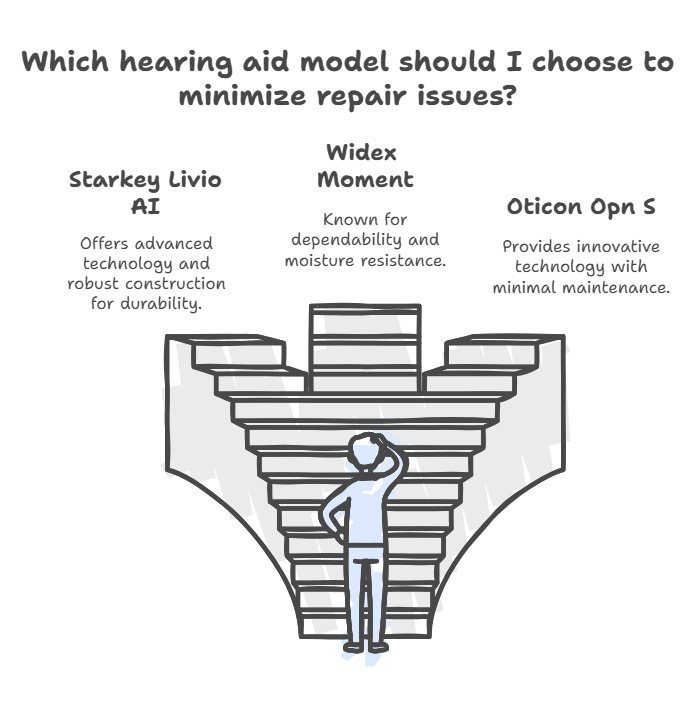
Recommended Hearing Aid Models to Avoid Repair Issues
Starkey Livio AI
Advanced Technology for Durability:
Starkey Livio AI hearing aids are designed with cutting-edge technology, including artificial intelligence for better sound clarity and smart functionality. The device’s robust construction reduces the likelihood of physical damage.
Features to Avoid Repair Issues:
– Long-lasting battery life with energy-efficient features
– Built-in sensors to detect environmental changes for optimal sound processing
– Water-resistant design that prevents damage from moisture exposure
Phonak Audeo Marvel
Dependability with Robust Construction:
Phonak’s Audeo Marvel series is known for its durability, offering a wide range of models for various hearing needs. These devices are designed to handle both everyday wear and more extreme conditions, like humidity.
Features to Avoid Repair Issues:
– Bluetooth connectivity with minimal lag or disconnection issues
– Quick charging capabilities for convenience and longer battery life
– Moisture and sweat-resistant casing to prevent issues due to humidity
Oticon Opn S
Innovative Technology with Minimal Maintenance:
Oticon Opn S hearing aids offer excellent sound quality with a focus on reducing the need for frequent adjustments or repairs. They are designed to last longer with fewer issues over time.
Features to Avoid Repair Issues:
– Rechargeable battery options to eliminate the need for frequent battery replacements
– Windproof microphones that maintain clear sound quality
– Sound stabilization technology that adapts to varying environments, reducing wear on internal components
Resound Linx Quattro
Durability and High-Quality Sound:
Resound Linx Quattro models combine high durability with enhanced sound processing. They are ideal for active users and those living in environments with varying noise levels.
Features to Avoid Repair Issues:
– Rechargeable batteries for longer use and fewer replacements
– Water-resistant design to protect against moisture buildup
– Strong, long-lasting materials that handle physical wear without compromising function
Signia Pure Charge&Go X
Reliable and Efficient with Minimal Maintenance Needs:
Signia’s Pure Charge&Go X models provide reliable performance with the benefit of minimal maintenance, making them ideal for individuals who want to avoid frequent repairs and battery issues.
Features to Avoid Repair Issues:
– All-day battery life that avoids frequent charging
– Smartphone connectivity for easy adjustments and firmware updates
– Resistant to dust and moisture ensuring long-term performance
Widex Moment
Next-Generation Sound Clarity and Durability:
Widex Moment hearing aids use a unique sound processing technology that ensures high clarity and natural sound, reducing the need for constant repairs.
Features to Avoid Repair Issues:
– Minimal maintenance requirements with advanced protection against moisture and dust
– Battery-saving technology that extends life between charges
– Advanced sound processing that minimizes the likelihood of technical issues. Selecting a durable, high-quality hearing aid model can minimize the need for frequent repairs and maintenance. The recommended models—Starkey Livio AI, Phonak Audeo Marvel, Oticon Opn S, Resound Linx Quattro, Signia Pure Charge&Go X, and Widex Moment—are known for their reliability and advanced features that help reduce common repair issues. When choosing a model, consider factors such as battery life, resistance to moisture, and overall durability to ensure the longevity and performance of your hearing aids.
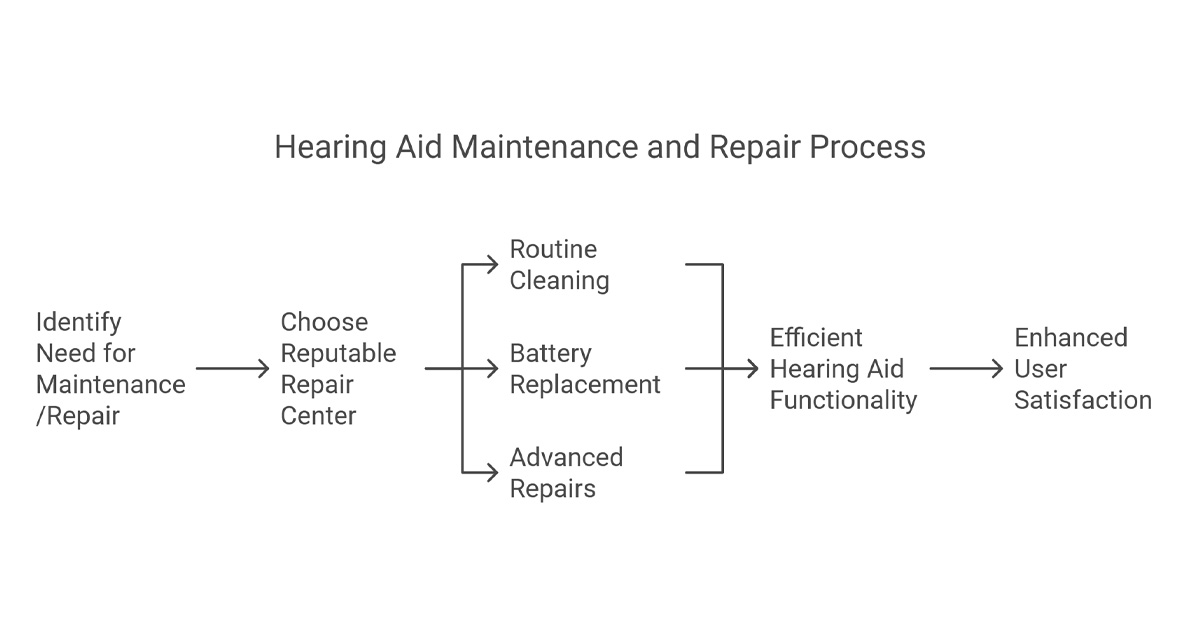
Conclusion
When it comes to maintaining and repairing hearing aids in Dhaka, the expertise and reliability of a dedicated repair center make all the difference. With a wide range of services—from routine cleaning and battery replacement to advanced circuit board repairs—Rehab Hearing & Speech Center ensures that hearing aids continue to function efficiently and effectively. By choosing a reputable center with skilled technicians, users can expect quick turnarounds, excellent customer support, and long-lasting solutions to their hearing aid issues. Regular maintenance and professional repairs not only extend the life of hearing aids but also contribute to the overall hearing health and satisfaction of users. With the right care, hearing aids can continue to provide the clarity and connection needed for an enriched life.
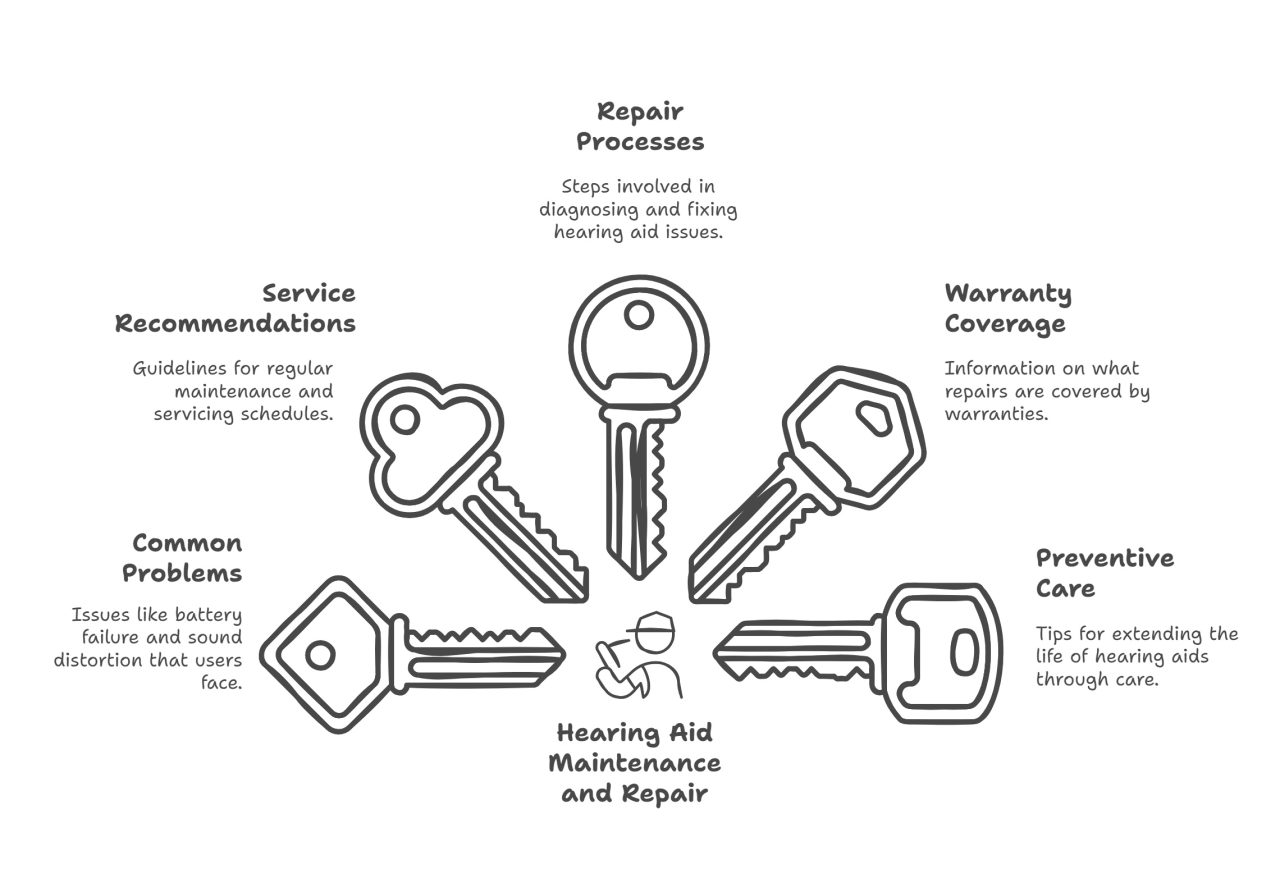
Frequently Asked Questions
1. What common problems can occur with hearing aids?
Common issues with hearing aids include battery problems, sound quality issues (such as distortion or muffling), devices not turning on, feedback noises (whistling or buzzing), connectivity issues with Bluetooth, physical damage, and moisture or earwax buildup affecting performance.
2. How often should I get my hearing aids checked or serviced?
It’s recommended to have your hearing aids, including digital hearing aids serviced at least once a year for general maintenance. However, if you notice any issues such as poor sound quality, device malfunctions, or physical damage, it’s advisable to visit a hearing aid repair center immediately.
3. Can hearing aid repairs be done on the same day?
Yes, minor repairs such as battery replacements, cleaning, or adjustments can often be completed on the same day. However, more complex repairs, such as circuit board issues or component replacements, may take longer, depending on the severity of the problem.
4. What should I do if my hearing aid is not turning on?
If your hearing aid is not turning on, check the battery and ensure it’s properly installed. If the issue persists, it could be due to a corroded battery compartment or a more significant internal issue, and you should bring it to a hearing aid repair center for inspection and repair.
5. How can I prevent hearing aid issues?
To prevent common hearing aid issues, regularly clean your devices to avoid earwax or moisture buildup. Store them in a safe, dry place when not in use and avoid exposing them to extreme temperatures, high humidity, or physical shocks. Regular professional check-ups can also help catch minor problems before they become bigger issues.
6. Are repairs covered by warranties?
Many hearing aid models come with a warranty that covers repairs within a certain period, usually for defects in materials or workmanship. However, repair costs for damage caused by external factors, such as moisture, physical impact, or improper use, may not be covered under the warranty. It’s important to check with your hearing aid provider for specific warranty details.
7. How long does a hearing aid repair typically take?
The time required for a hearing aid repair depends on the type of problem. Minor issues like battery changes, cleaning, or adjustments can be resolved within a few hours or on the same day. More complex repairs, such as internal circuit board issues, may take a few days. It’s always best to check with the center for estimated repair times.
8. Can hearing aid service centers handle all types of hearing aids?
Yes, reputable hearing aid service centers in Dhaka can service a wide range of hearing aid brands and models. They typically have the expertise and equipment to repair popular brands like Starkey, Phonak, Vibe hearing aids, etc. Ensure that the repair center you choose is equipped to handle your specific hearing aid model.
9. Is it better to repair or replace my hearing aid?
If your hearing aid is still under warranty or relatively new, repairs are usually the best option. However, if the device is old and has frequent issues, replacing it with a newer model may be more cost-effective in the long run. A hearing aid professional can help you decide the best course of action based on the condition of your device.
10. How much does hearing aid repair cost in Dhaka?
The cost of hearing aid repairs in Dhaka can vary depending on the type of repair needed. Minor repairs may cost less, while more complex issues could be more expensive. It’s a good idea to contact the repair center for an estimate before proceeding with any repairs. Keep in mind that the use of genuine parts and high-quality service may influence repair prices.
11. What happens if moisture or earwax gets inside my hearing aid?
Moisture and earwax buildup can cause significant damage to hearing aids, leading to malfunctions like distorted sound or failure to turn on. Regular cleaning and the use of protective cases or drying kits can help prevent these issues. If moisture or earwax is already inside, it’s best to bring the device to a hearing aid repair shop for thorough cleaning and maintenance.
12. Do hearing aids require special cleaning tools?
Yes, all hearing aids, including digital hearing aids require special cleaning tools like a soft brush, wax pick, and cloth to prevent damage. Cleaning kits specifically designed for hearing aids can help remove earwax and moisture without causing harm to the delicate components. Many repair centers also offer professional cleaning services to ensure thorough and safe cleaning.
13. What should I do if my hearing aid is making a whistling sound?
Whistling or feedback sounds are often caused by improper fitting, a damaged microphone, or an issue with the device’s microphones. It could also be a sign of earwax buildup. A hearing aid repair center can diagnose and fix the issue by adjusting the fit, repairing components, or cleaning the device.
14. Can hearing aids be repaired if they are physically damaged?
Yes, physical damage such as broken casing, tubing, or wires in Behind-the-Ear (BTE) models can usually be repaired. A professional repair center can replace damaged parts and restore the hearing aid to full functionality.
15. How can I extend the life of my hearing aid?
To extend the life of your hearing aids, including IIC hearing aids, practice proper cleaning and storage routines, avoid exposure to moisture or extreme temperatures, and replace batteries regularly. Scheduling periodic professional check-ups for maintenance can also help detect minor issues early, preventing major repairs.
16. Can hearing aids be repaired for Bluetooth or connectivity issues?
Yes, many hearing aid repair centers specialize in fixing Bluetooth and connectivity problems. These issues could be related to software glitches, outdated firmware, or hardware malfunctions. Technicians will be able to diagnose the problem and perform necessary updates or repairs.
17. What is the process for getting a hearing aid repaired?
The process typically involves bringing your hearing aid to the repair center, where a technician will evaluate the device and identify the issue. After diagnosis, you will be informed of the repair costs and timeline. Once the repair is complete, the device will be tested to ensure it functions properly before being returned to you.
18. Is it necessary to get hearing aids professionally repaired, or can I fix them myself?
While minor issues like battery replacement can be done at home, it’s recommended to have a professional technician handle repairs involving internal components, moisture damage, or issues with the electronics. DIY fixes can sometimes lead to further damage and void warranties, so it’s best to seek professional assistance for complex repairs.
19. What are some signs that my hearing aid needs repair?
Signs that your hearing aid may need repair include poor sound quality (distorted, muffled, or no sound), buzzing or whistling noises, the device not turning on, feedback sounds, difficulty with Bluetooth connectivity, or physical damage. If you notice any of these issues, it’s a good idea to visit a repair center for a professional diagnosis.
20. Can I get a loaner device while my hearing aid is being repaired?
Many hearing aid repair centers offer loaner devices while yours is being repaired. This can be especially helpful for individuals who rely on their hearing aids, including CIC hearing aids for daily communication. Be sure to inquire about loaner options when scheduling your repair.

